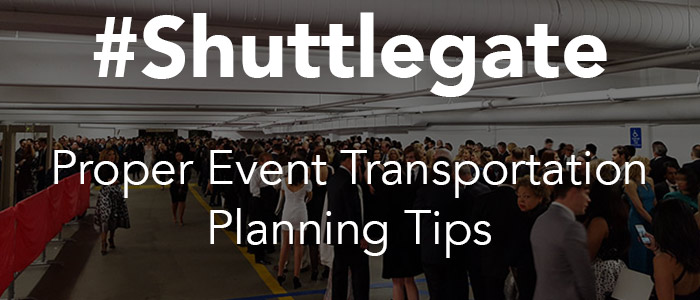 Original image via The Hollywood Reporter
Original image via The Hollywood Reporter
At Brilliant, we’ve been outspoken that transportation is the first, and last impression attendees have at an event. As we all know, first and last impressions leave an indelible overall feeling of the event in attendee’s mind. As such, transportation should be prioritized in the early stages of the event planning process, that way it can be a part of the event, not an added on service.
Shuttlegate: What Happened and Expert Event Transportation Tips on Avoiding in the Future

via The Hollywood Reporter
Last weekend at the Golden Globes was one of the most high profile cases where event transportation was not prioritized properly or given enough thought. The Hollywood Reporter has deemed it “Shuttlegate.” If you haven’t heard about the shuttlegate debacle already, here is a brief overview:
-
After a successful night at the Golden Globes, attendees were gearing up for a night of partying and celebration. Most guests attend the after-party at the Beverly Hilton Hotel.
-
Attendees were told to meet in a parking structure on Avenue of the Stars to be shuttled to the Beverly Hilton, about 1.5 miles away.
-
Upon arrival, many guests were not thrilled to find a long serpentined line of angry guests waiting to continue the night’s festivities.
-
A lack of proper transportation planning resulted in most guests waiting in line over 3 hours!
-
The crowd became so frustrated that one reveler said: “This is like a prison camp!”
-
Apparently the scene was quite surreal as the crowd of formally dressed industry pros were seen taking off their stilettos and sitting on the ground.
-
After hours of waiting, guests finally arrived at the Beverly Hilton to dance the night away. Well….only for about 35 minutes since the party ended at 12:30 am.
-
Thus, we now have a ruined event and a new industry term to attach to it - SHUTTLEGATE.
One question we always ask here at Brilliant is,
“What’s the cost of failure?”
According to the Hollywood Reporter the cost of the after-parties is in excess of $2 million. With a little more budget, time, and energy the night wouldn’t have been wasted.
Event planners might be wondering,
“How could this whole operation have run seamlessly?”

via The Hollywood Reporter
Here are the best event transportation tips to avoid such a situation:
1) Include Transportation in the Design Phase
Generally speaking, we see event and wedding planners handling the logistics, routing, scheduling of the entire transportation program and handing a manifest or spreadsheet to be executed blindly. Perhaps this occurs because over time planners have realized their questions and design needs are met with blank stares or over promises and disappointment.
But, if you want a successful ground program, you need to invest in hiring professionals that listen, add value, and design their own program (in partnership and with your approval) in order to ensure success. Makes perfect sense, doesn't it? You wouldn't instruct the tent company on how exactly to build the tent, right? You would discuss the aesthetic, the placement, listen to concerns about the wind and the ground underneath, and continue to discuss until a mutual solution was agreed upon. The same should be true for ground transportation.
2) Plan for Variability
While every professional trade has some variability (“the flowers don't look as fresh as I want”), transportation is a logistic nightmare with lots of room for error including: chauffeur error or unpreparedness, unexpected traffic, accidents, unfavorable weather conditions, vehicle malfunctions, etc.
However, since the variability can be broken down to core components and analyzed individually, proper planning can easily overcome these traditional excuses. In addition, you can prepare for the unexpected and have backup plans and procedures so that clients remain unaware of any snafus that may have otherwise caused delay, or worse.
In the case of #SHUTTLEGATE,
the construction in LA was not accounted for and, therefore, made the transport from the pickup location
to the Beverly Hilton nearly 20x longer causing major problems.
3) Hire for Hospitality
Transportation companies are super focused on one thing: getting you from A to B. Hopefully safely, and on time. But, there is little energy, training or understanding of the service component of the business - the hospitality.
In every other service, the professionals are groomed, friendly, hospitable and chosen for their “front of the house” capabilities. However, transportation as an industry doesn't offer many viable options and therefore, does not go through similar scrutiny and often is picked by low budget.
If you lower your criteria, you can expect a lower quality service. And, if you know you are getting a lower quality service, you will spend additional resources attempting to fix or overcome that weakness by assigning multiple junior staffers (which has additional costs and implications for you, your staff, and may even result in client dissatisfaction).
4) Don’t Plan Transportation Last
Typically we’ve found that event planners don’t prioritize ground transportation and therefore leave it until the very end to plan. As such, most of their event budget is usually dried up by this point and they have to go for a cheap option. This circles back to not including transportation into the design phase and viewing it as an add on service which clearly happened during “shuttlegate”.
5) Hire On-site Coordinators
Often we see poor judgment caused by budget considerations whereby the planner will use multiple junior staffers to coordinate and dispatch all of the transportation. However, that is not their expertise, and they are unfamiliar with the vehicles, the chauffeurs, the routing, difficult conditions that may delay the service such as poor lighting or one lane bridges, etc.
In addition, we’ve found that chauffeurs communicate best with professional coordinators and dispatchers who can quickly and in uniform common language communicate their exact specifications and consequently, they are able to execute.
We highly recommend spending a bit more and hiring professionals to coordinate your ground transportation program.
The cost is negligible in the overall cost of the event and may, in fact,
be some of the best money you spend.
6) Perform Dry Runs
Have your transportation team arrive on location at least once, ideally twice (we’ve done as many as 4 when needed due to challenging conditions) and do the actual trip (we wrote a blog on when you should perform dry runs). Monitor how long it takes, traffic flow, tight turns, limited parking / staging, low clearance, and other potential bottlenecks. Doing so in advance, and planning and communicating clearly to the team BEFORE game day will make the actual process flow much smoother with less variability (another problematic element discussed earlier). Do not consider this an extra cost or expense. Consider this a must for anything requiring exacting specifications or with a degree of difficulty.
If you want some more tips on how to ensure debacles like this don’t happen at your next event download our free ebook: 9 Reasons Why Event Transportation Can Be a Nightmare (and how to fix it).
